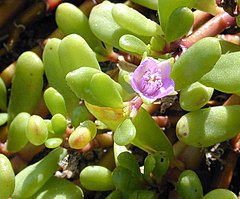Aizoaceae: Difference between revisions
→Uses: move, mention edible, and note name “ice plant” |
|||
| Line 192: | Line 192: | ||
* [http://www.flora.sanbi.org/its_page?comID=3 P. Chesselet (2004 onwards). Interactive Mesembs2] |
* [http://www.flora.sanbi.org/its_page?comID=3 P. Chesselet (2004 onwards). Interactive Mesembs2] |
||
*[http://www.museums.org.za/bio/plants/aizoaceae/index.htm Aizoaceae of South Africa] |
*[http://www.museums.org.za/bio/plants/aizoaceae/index.htm Aizoaceae of South Africa] |
||
*[http://www.flowersinisrael.com/FamAizoaceae.html Family Aizoaceae] Flowers in Israel |
|||
{{commonscat|Aizoaceae}} |
{{commonscat|Aizoaceae}} |
||
Revision as of 14:59, 3 September 2008
| Aizoaceae | |
|---|---|

| |
| Sesuvium portulacastrum | |
| Scientific classification | |
| Kingdom: | |
| Division: | |
| Class: | |
| Order: | |
| Family: | Aizoaceae |
| Genera | |
|
See text | |
The Family Aizoaceae or Ficoidaceae (fig-marigold family or ice plant family) is a taxon of dicotyledonous flowering plants containing 135 genera and about 1900 species. They are commonly known as stone plants or carpet weeds. Species that resemble stones or pebbles are sometimes called mesems. Several species are know as ice plant.
Description
The family is widely recognised by taxonomists, although once it went by the botanical name "Ficoideae", now disallowed. The APG II system of 2003 (unchanged from the APG system of 1998) also recognises the family, and assigns it to the order Caryophyllales in the clade core eudicots. The APG II system also classes the former families Mesembryanthemaceae Fenzl (1836) , Sesuviaceae Horan. (1834) and Tetragoniaceae Link (1831) under the family Aizoaceae.
Most species (96 %, 1782 species in 132 genera) in this family are endemic to arid or semi-arid parts of southern Africa [1], but a few are from Australia and the Central Pacific. Most of these species are succulents and belong to the subfamilies Mesembryanthemoideae and Ruschioideae and are loosely termed mesems or mesembs.
Most fig-marigolds are herbaceous, rarely somewhat woody, with stems growing either erect or prostrate. Leaves are simple, opposite or alternate, and more or less succulent with entire (or rarely toothed) margins. Flowers are perfect in most species (but unisexual in some), actinomorphic, and appear singularly or in few-flowered cymes developing from the leaf axils. Sepals are typically 5 (3-8) and more or less connate (fused) below. True petals are absent. However, some species have numerous linear petals derived from staminoides. The fruit is a capsule with one to numerous seeds per cell.
A few species (especially Carpobrotus edulis, commonly called Ice Plant) have been widely introduced and become invasive.
Uses
Several Aizoaceae are edible, including:
- Carpobrotus edulis and Mesembryanthemum crystallinum have edible leaves, and are both commonly called Ice Plant
- A species known as New Zealand spinach (Tetragonia tetragonioides) is grown as a garden plant in somewhat dry climates and used as an alternative to spinach in upscale salads.
Carpobrotus edulis was introduced to California to stabilize soil along railroad tracks.
Subfamilies
- Aizooideae
- Sesuvioideae
- Tetragonioideae
- Mesembryanthemoideae
- Ruschioideae
Genera






Footnote
- ^ Chesselet, P., Smith, G.F., Burgoyne, P.M., Klak, C., Hammer, S.A., Hartmann, H.E.K., Kurzweil, H., van Jaarsveld, E.J., van Wyk, B-E. & Leistner, O.A (2000). "Seed Plants of Southern Africa". Strelitzia. 10: 360–410.
{{cite journal}}: CS1 maint: multiple names: authors list (link)
References and external links
- Bittrich V. H. E. K. Hartmann (1988). "The Aizoaceae — a new approach". Bot. J. Linn. Soc. 97: 239–254. doi:10.1111/j.1095-8339.1988.tb01581.x.
{{cite journal}}: Unknown parameter|quotes=ignored (help) - Cornelia Klak, Angeline Khunou, Gail Reeves and Terry Hedderson (2003). "A phylogenetic hypothesis for the Aizoaceae (Caryophyllales) based on four plastid DNA regions". Amer. J. Bot. 90: 1433–1445. doi:10.3732/ajb.90.10.1433.
{{cite journal}}: Unknown parameter|quotes=ignored (help)CS1 maint: multiple names: authors list (link) - on line here - Aizoaceae in L. Watson and M.J. Dallwitz (1992 onwards). The families of flowering plants
- NCBI Taxonomy Browser
- P. Chesselet (2004 onwards). Interactive Mesembs2
- Aizoaceae of South Africa
- Family Aizoaceae Flowers in Israel
